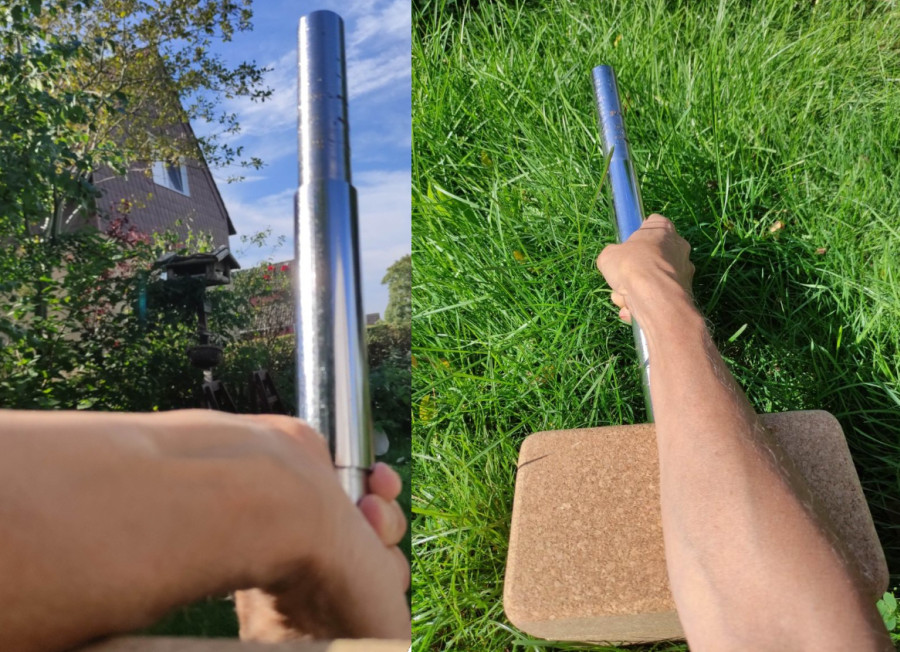yogabook / functional exercises / practicing radial abduction and ulnar abduction
Contents
Practicing radial abduction and ulnar abduction

Feedback: We’d love to hear what you think about this description, give us feedback at:
postmeister@yogabook.org
last update: 30.10.2023
Level: A
- Classification
- Contraindication
- Effects
- Preparation
- Follow-up
- derived asanas
- similar asanas
- Diagnostics
- Instructions
- Details
- Variants
Classification
Functional exercise
Contraindication
In the case of a golfer’s elbow, a special procedure described below applies to the execution of pronation; the same applies to supination in the case of a tennis elbow.
Diagnostics
Pain occurring on the medial epicondyle of the humerus during pronation of the arm is highly likely to indicate a golfer’s elbow, but radial abduction and palmar flexion may also be indicative. Localized tenderness at the medial epicondyle and in the area of the tendons immediately adjacent distally confirms the suspicion. If there is tenderness at the lateral ep icondyle and pain on supination as well as pain on dorsiflexion or ulnar abduction, a tennis elbow should be suspected. Note that mixed types of golfer’s elbow and tennis elbow are not uncommon. It is also possible for both disorders to occur simultaneously.
Instructions
- This exercise can be used to strengthen both the ulnar and dorsal abductors. Sit on a chair or stand. Hold the forearm vertically next to the pelvis with the palm facing the pelvis. Hold a dumbbell bar with a central grip and bend the wrist in an ulnar or radial direction. If this proves to be well tolerated, the dumbbell bar can be gripped asymmetrically so that the longer part is on the ulnar or radial side and the corresponding muscles can be strengthened.
- For the radial abduction, place your forearm horizontally in front of you on a suitable elevation such as a weight bench, two or three flat stacked blocks or an appropriate number of shoulder support plates so that the forearm can move freely with the barbell. If no aid is available, this can also be your own thigh in a seated position. There are two options for ulnar abduction: a) place the forearm on an elevation at about shoulder height with the upper arm turned in far or b) let the arm hang next to the body.
- Depending on the desired load, grip an unloaded dumbbell bar a little to far from the center so that the longer end is on the side of the thumb.
- Tilt the wrist with the barbell exactly in the direction of radial abduction or ulnar abduction and avoid bending the wrist in the direction of dorsiflexion or palmar flexion.
Details
- Unlike the exercise practicingsupination and pronation of the arm, both movements cannot be practiced simultaneously in one set-up. Only with the arm hanging down as described in b) can a certain degree of radial abduction be practiced at the same time. Note, however, that the effect of gravity is significantly less favorable during execution and therefore the effect is significantly less than in a) with the forearm horizontal, where it is maximum with the wrist exactly extended, which is why these variations are also recommended.
- The effectiveness of the exercise can be determined by the exact point at which the bar is gripped, i.e. the ratio of the two (radial and ulnar) protrusions of the bar. If the effectiveness is not sufficient, the barbell can be fitted with a suitable washer.
- Due to the course of the muscles involved, which are mainly palmar flexors and dorsiflexors of the wrist, it is important to pay close attention so that the hand only performs the desired movements with the barbell and not dorsiflexion and palmar flexion in the wrist.
- In golfer’s elbow, the flexor carpi ulnaris and the flexor carpi radialis, i.e. the two palmar flexors originating from the medial epicondyle, can be affected; in the case of tennis elbow, the two wrist dorsiflexors extensor carpi radialis brevis (not the extensor carpi radialis longus, as this originates from the sulcus behind it) and the extensor carpi ulnaris. If the respective muscles show signs of pain on exertion, exercise should predominantly be performed below the threshold of pain triggering. In addition, a pain release of NRS 6 to 8 can be held once in an isometric position with a long sarcomere length for 10 to 30 seconds and it can be observed whether the pain decreases noticeably. This procedure can then be practiced up to three times a day, but the majority of the time should be practiced with a maximum of NRS 2 to 3.
